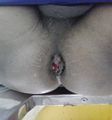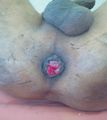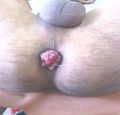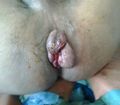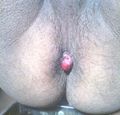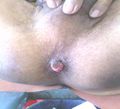Arsha Chikitsa
| Section/Chapter | Chikitsa Sthana Chapter 14 |
|---|---|
| Preceding Chapter | Udara Chikitsa |
| Succeeding Chapter | Grahani Chikitsa |
| Other Sections | Sutra Sthana, Nidana Sthana, Vimana Sthana, Sharira Sthana, Indriya Sthana, Kalpa Sthana, Siddhi Sthana |
Chikitsa Sthana Chapter 14, Chapter on management of Arsha (Hemorrhoids)
Abstract
This chapter of Chikitsa Sthana exclusively deals with the treatment of guda arsha (piles/hemorrhoids). Congenital and acquired types, their causes, clinical features of dosha dominance and management are elaborated. The usual treatment of hemorrhoids is surgical, but if proper treatment is received it can be best managed with medicinal treatment. The disease arsha is mentioned in the Ashtomahagada (group of eight diseases that are difficult to cure).
Recurrence rate of hemorrhoids is high, even after surgical intervention. Sushruta has mentioned that any disease, if can be cured with the medicine is not required to be treated with shodhana and shastrakarma (surgical intervention). So, every attempt should be made to treat hemorrhoids with medicinal treatment, diet and lifestyle changes. Different medicinal formulations for conservative management and local applications, soothing therapy, sitz bath, fumigation, and sprinkling with the herbs are some of the modes of treatment prescribed to relieve the local inflammation, bleeding and maintain the peri-anal hygiene to control the disease. The principal of treatment is to avoid the nidana (causative factors), with diet being one of them. Digestive power of the person should be strong, which can be maintained with the consumption of different types of thin and thick gruels. Anuvasana basti is used for management of constipation, the root cause of arsha. Raktamokshana (bloodletting), in cases of vitiation of rakta, is advised. Finally, it is evident that treatment of hemorrhoids is multifocal and no single modality is effective including surgery.
Keywords: Arsha, anuvasana basti, raktamokshana, hemorrhoids, shodhana chikitsa, soothing therapy, sitz bath, fumigation, asava, arishta, churna, vati
Introduction
This chapter is followed by udara roga because the causative factors for both the diseases are similar like vitiation of tridosha. Both the diseases are related to the same system i.e. gastrointestinal tract. Further, arsha is one of the causative factors of udara roga (Boddhagudedara- intestinal obstruction) Therefore the chapter dealing with arshas (hemorrhoids) follows the chapter on the treatment of udara (obstinate abdominal disorders).
The chapter describes types of arsha (such as congenital or acquired), sites of manifestation other than the ano-rectal region, doshic signs and symptoms, etio-pathogenosis, etiology of the doshaja arsha, and prognosis along with the symptoms of curable and incurable hemorrhoids. Hemorrhoids can be shushka (dry or non-bleeding) and sravi (wet or bleeding) with different modes of treatment for each of these. In the bleeding type hemostatic management is essential while in non- bleeding type hemostatic treatment is not needed.
The dry hemorrhoids can be correlated with the external hemorrhoids where protrusion of mucosal folds occur, without bleeding. Local treatment includes, fomentation, sitz bath, sprinkling, smearing and fumigation and topical medicament. The need of proper hygiene of the peri-anal area is important. Raktamokshana (bloodletting) was advised as one of the para-surgical procedure and in cases of vitiation of rakta and predominance of pitta dosha. Oral intake of the herbal powders, takraarishta, abhayaarishta, dantyaarishta, phalaarishta are described along with their method of preparation. In pathya the recipes like thick gruel, curd, buttermilk, leafy vegetables for vegetarian and meat as well as meat soup for non-vegetarian was advised in cases of constipated bowel. It proves that along with the other causative factors constipation is an important cause. The role of haritaki with jaggery is one of the requirements for deepana and pachana because the cause of arsha is depressed digestive power. The other recipes like ghrita, preparations like pippalyadi ghrita, chavyadi ghrita, nagaradi ghrita in constipated patients. The anuvasana basti is advisable with medicated taila in the management of dry or external hemorrhoids.
The wet hemorrhoids have the predominance of kapha along with vata and can be correlated with internal hemorrhoids which are usually bleeding in nature. The line of treatment as per predominance of vata or kapha has been described. In initial stage the bleeding should not be stopped as the vitiated blood should be let out. Later on kutajadi rasakriya for hemostatis, thick and thin gruel remedies were explained. Cooling therapy, sprinkling therapy with different herbal preparations, warm and cold water sitz bath was advised in the cases of bleeding. Recipes of curds and rice in the diet are also recommended. For local treatment external application of cold leaves, soothing ointment, rubbing recipes and topical application in the bleeding hemorrhoids are described.
Sanskrit text, Transliteration and English Translation
अथातोऽर्शश्चिकित्सितं व्याख्यास्यामः||१||
इति ह स्माह भगवानात्रेयः||२||
athāto’rśaścikitsitaṃ vyākhyāsyāmaḥ||1||
iti ha smāha bhagavānātreyaḥ||2||
athAto~arshashcikitsitaM vyAkhyAsyAmaH||1||
iti ha smAha bhagavAnAtreyaH||2||
We shall now expound the treatment of hemorrhoids. Thus said Lord Atreya. [1-2]
आसीनं मुनिमव्यग्रं कृतजाप्यं कृतक्षणम्|
पृष्टवानर्शसां युक्तमग्निवेशः पुनर्वसुम्||३||
प्रकोप हेतुं संस्थानं स्थानं लिङ्गं चिकित्सितम्|
साध्यासाध्य विभागं च तस्मै तन्मुनिरब्रवीत्||४||
āsīnaṃ munimavyagraṃ kṛtajāpyaṃ kṛtakṣaṇam|
pṛṣṭavānarśasāṃ yuktamagniveśaḥ punarvasum||3||
prakopa hetuṃ saṃsthānaṃ sthānaṃ liṅgaṃ cikitsitam|
sādhyāsādhya vibhāgaṃ ca tasmai tanmunirabravīt||4||
AsInaM munimavyagraM kRutajApyaM kRutakShaNam|
pRuShTavAnarshasAM yuktamagniveshaH [1] punarvasum||3||
prakopahetuM saMsthAnaM sthAnaM li~ggaM cikitsitam|
sAdhyAsAdhyavibhAgaM ca tasmai tanmunirabravIt||4||
To Punarvasu (Lord Atreya), who was in calm pose after having completed his religious rituals, Agnivesha inquired about the etiology, aggravating factors, shape, size, location, clinical features, treatment and prognosis of arsha (hemorrhoids). Then Lord Atreya responded. [3-4]
Types of hemorrhoids
इह खल्वग्निवेश! द्विविधान्यर्शांसि- कानिचित् सहजानि, कानिचिज्जातस्योत्तरकालजानि|
तत्र बीजं गुदवलि बीजोप तप्तमायतनमर्शसां सहजानाम्|
तत्र द्विविधो बीजोपतप्तौ हेतुः- मातापित्रोरपचारः, पूर्वकृतं च कर्म; तथाऽन्येषामपि सहजानां विकाराणाम्|
तत्र सहजानि सह जातानि शरीरेण, अर्शांसीत्यधिमांसविकाराः||५||
iha khalvagniveśa! dvividhānyarśāṃsi- kānicit sahajāni, kānicijjātasyottarakālajāni|
tatra bījaṃ gudavali bījopa taptamāyatanamarśasāṃ sahajānām|
tatra dvividho bījopataptau hetuḥ- mātāpitrorapacāraḥ, pūrvakṛtaṃ ca karma; tathā’nyeṣāmapi sahajānāṃ vikārāṇām|
tatra sahajāni saha jātāni śarīreṇa, arśāṃsītyadhimāṃsavikārāḥ||5||
iha khalvagnivesha! dvividhAnyarshAMsi- kAnicit sahajAni, kAnicijjAtasyottarakAlajAni|
tatra bIjaM gudavalibIjopataptamAyatanamarshasAM sahajAnAm|
tatra dvividho bIjopataptau hetuH- mAtApitrorapacAraH, pUrvakRutaM ca karma; tathA~anyeShAmapisahajAnAM vikArANAm|
tatra sahajAni saha jAtAni sharIreNa, arshAMsItyadhimAMsavikArAH||5||
O Agnivesha!, The arsha is of two types:
- Congenital
- Acquired (manifested after the birth).
Congenital hemorrhoids are caused by the vitiation of the beeja dosha (deformity in sperm and ovum), specially the part of the anal canal or anal sphincters. This vitiation of the beeja dosha is caused by two groups of factors:
- The wrong diet and regimen of parents (father/mother)
- The sinful acts of the past life of individuals.
These two categories of causative factors are also responsible for all the other congenital disorders in the human body. Sahaja means the disorder which is manifested along with the appearance of the body parts since birth. Arsha (hemorrhoids) is characterized by morbid growth in the muscle tissue. [5]
Locations of hemorrhoids
सर्वेषां चार्शसां क्षेत्रं- गुदस्यार्ध पञ्चमाङ्गुलावकाशे त्रिभागान्तरास्तिस्रो गुदवलयः क्षेत्रमिति; केचित्तु भूयांसमेव देशमुपदिशन्त्यर्शसां- शिश्नमपत्यपथं गल तालु मुख नासिका कर्णाक्षि वर्त्मानि त्वक् चेति|
तदस्त्यधि मांस देशतया, गुदवलिजानां त्वर्शांसीति सञ्ज्ञा तन्त्रेऽस्मिन्|
सर्वेषां चार्शसामधिष्ठानं- मेदो मांसं त्वक् च||६||
sarveṣāṃ cārśasāṃ kṣetraṃ- gudasyārdha pañcamāṅgulāvakāśe tribhāgāntarāstisro gudavalayaḥ kṣetramiti; kecittu bhūyāṃsameva deśamupadiśantyarśasāṃ- śiśnamapatyapathaṃ gala tālu mukha nāsikā karṇākṣi vartmāni tvak ceti|
tadastyadhi māṃsa deśatayā, gudavalijānāṃ tvarśāṃsīti sañjñā tantre’smin|
sarveṣāṃ cārśasāmadhiṣṭhānaṃ- medo māṃsaṃ tvak ca||6||
sarveShAM cArshasAM kShetraM- gudasyArdhapa~jcamA~ggulAvakAshe tribhAgAntarAstisro gudavalayaHkShetramiti; kecittu bhUyAMsameva deshamupadishantyarshasAM- shishnamapatyapathaMgalatAlumukhanAsikAkarNAkShivartmAni tvak ceti|
tadastyadhimAMsadeshatayA, gudavalijAnAM [1] tvarshAMsIti sa~jj~jA tantre~asmin|
sarveShAM cArshasAmadhiShThAnaM- medo mAMsaM tvak ca||6||
The hemorrhoids are located in the space of four and half angulas (or approximately 8-10 cm) in the lower part of rectum and anal canal. This area has three sphincters dividing the space into three parts (guda vali). There are other locations of arshas (hemorrhoids) in the body in which excessive and unnatural growth of the muscle tissue also takes place, such as, pudendum, female genital tract, throat, palate, mouth, nose, ears, eyelids and skins. However, in this chapter the arsha occurring in the anal region are only considered as arsha (hemorrhoids). The adhishthana (involved morbid tissue elements) of all the types of arsha are medas (fatty tissue), mamsa (muscular tissue) and tvaka (skin and mucous membrane). [6]
Forms of congenital hemorrhoids
तत्र सहजान्यर्शांसि कानिचिदणूनि, कानिचिन्महान्ति, कानिचिद्दीर्घाणि, कानिचिद्ध्रस्वानि, कानिचिद्वृत्तानि, कानिचिद्विषमविसृतानि, कानिचिदन्तःकुटिलानि, कानिचिद्बहिःकुटिलानि, कानिचिज्जटिलानि, कानिचिदन्तर्मुखानि, यथास्वं दोषानुबन्धवर्णानि||७||
tatra sahajānyarśāṃsi kānicidaṇūni, kānicinmahānti, kāniciddīrghāṇi, kāniciddhrasvāni, kānicidvṛttāni, kānicidviṣamavisṛtāni, kānicidantaḥkuṭilāni, kānicidbahiḥkuṭilāni, kānicijjaṭilāni, kānicidantarmukhāni, yathāsvaṃ doṣānubandhavarṇāni||7||
tatra sahajAnyarshAMsi kAnicidaNUni, kAnicinmahAnti, kAniciddIrghANi, kAniciddhrasvAni, kAnicidvRuttAni,kAnicidviShamavisRutAni, kAnicidantaHkuTilAni, kAnicidbahiHkuTilAni, kAnicijjaTilAni,kAnicidantarmukhAni, yathAsvaM doShAnubandhavarNAni||7||
Among the congenital hemorrhoids, some are small, some are large, some are long, some are short, some are round, some are irregularly spread, some are curved internally, some are curved externally, some are matted together, and some are introverted. Their characteristics or forms are as per the doshas involved in their formation. [7]
Signs and symptoms of congenital hemorrhoids
तैरुपहतो जन्म प्रभृति भवत्यतिकृशो विवर्णः क्षामो दीनः प्रचुर विबद्ध वात मूत्र पुरीषः शर्कराश्मरीमान्, तथाऽनियतविबद्धमुक्तपक्वामशुष्कभिन्नवर्चा अन्तराऽन्तरा श्वेत पाण्डु हरित पीत रक्तारुण तनु सान्द्र पिच्छिल कुणपगन्ध्याम पुरीषोपवेशी, नाभि बस्ति वङ्क्षणोद्देशे प्रचुर परिकर्तिकान्वितः, सगुदशूल प्रवाहिका परिहर्ष प्रमेह प्रसक्त विष्टम्भान्त्रकूजोदावर्त हृदयेन्द्रियोपलेपः प्रचुर विबद्ध तिक्ताम्लोद्गारः, सुदुर्बलः, सुदुर्बलाग्निः, अल्पशुक्रः, क्रोधनो, दुःखोपचारशीलः, कास श्वास तमक तृष्णा हृल्लास च्छर्द्यरोचका विपाक पीनस क्षवथु परीतः, तैमिरिकः, शिरःशूली, क्षामभिन्नसन्नसक्तजर्जरस्वरः, कर्णरोगी, शून पाणिपाद वदनाक्षिकूटः, सज्वरः, साङ्गमर्दः, सर्व पर्वास्थि शूली च, अन्तराऽन्तरा पार्श्व कुक्षि बस्ति हृदय पृष्ठ त्रिकग्रहोपतप्तः, प्रध्यानपरः, परमालसश्चेति; जन्म प्रभृत्यस्य गुदजैरावृतो मार्गोपरोधाद्वायुरपानः प्रत्यारोहन् समानव्यानप्राणोदानान् पित्तश्लेष्माणौ च प्रकोपयति, एते सर्व एव प्रकुपिताः पञ्च वायवः पित्तश्लेष्माणौ चार्शसमभिद्रवन्त एतान् विकारानुपजनयन्ति; इत्युक्तानि सहजान्यर्शांसि||८||
tairupahato janma prabhṛti bhavatyatikṛśo vivarṇaḥ kṣāmo dīnaḥ pracura vibaddha vāta mūtra purīṣaḥ śarkarāśmarīmān, tathā’niyatavibaddhamuktapakvāmaśuṣkabhinnavarcā antarā’ntarā
Tattva Vimarsha
- The arsha is of two types viz. congenital and acquired (manifested after the birth).
- The congenital hemorrhoids are caused by the vitiation of the beeja dosha (deformity in sperm and ovum), specially the part of the anal canal or anal sphincters. This vitiation of the beeja dosha is caused by either wrong diet, lifestyle regimen of parents (father/mother) or by sinful acts of the past life of patient. These are also causes for all other congenital disorders.
- Arsha (hemorrhoids) is characterized by morbid growth in the muscle tissue. The adhishthana (involved morbid tissue elements) of all the types of arsha are medas (fatty tissue), mamsa (muscular tissue) and tvaka (skin and mucous membrane).
- Characteristics or forms of all hemorrhoids are as per the doshas involved in their formation.
- In pathophysiology of arsha, apana vayu gets obstructed by the hemorrhoid-mass and moves upwards leading to aggravation of samana vayu, vyana vayu, prana vayu, udana vayu, pitta and kapha dosha. When all these five types of vayu, pitta and kapha get aggravated the individual suffers from morbidities of hemorrhoids.
- The causes of vataja arsha include habitual intake of astringent, pungent, bitter, ununctuous, cold and light food; habitual intake of pramitashana (food measured in extremely small quantities), intake of less quantity of food, intake of excess alcoholic drinks and indulgence in sexual acts; fasting, living in cold country and cold season, excess physical exercise, grief and exposure to sun and wind.
- The causes of pittaja arsha include intake of pungent, hot, salty and alkaline food; excess exercise and exposure to the heat of fire and Sun; living in a place and season which are not cold, intake of alcohol and envy; Intake of drinks, food and drugs having vidahi (causing burning sensation), sharp and hot properties.
- The causes of kaphaja arsha (hemorrhoids) include sweet, unctuous, cold, salty, sour and heavy food; lack of exercise, sleeping during day time, excess sleeping and sitting; direct exposure to wind, living in cold place and exposure to cold season and mental inactivity.
- Hemorrhoids always include aggravation of all the three doshas. Predominance of one or all the doshas determine the type of hemorrhoids.
- Five types of vayu (prana, apana, vyana, udana and samana), pitta and kapha - all these morbid factors in their aggravated state afflict the three anal sphincters at ano-rectum and lead to hemorrhoids.
- Excision of the hemorrhoids by sharp instruments, cauterization with ksharakarma (alkalies) and agnikarma (thermal cauterization) are three modalities in the management of arsha.
- Hemorrhoids caused by aggravation of vayu and kapha are ‘dry hemorrhoids’. Whereas those with excess discharge (bleeding) and wetness are caused by aggravation of rakta and pitta.
- Dry, hard, inflamed and painful hemorrhoids should be first treated with fomentation in the form of avagaha (sitz bath in medicated decoction), abhyanga (local massage with medicated oils), sprinkling of medicated water, fumigation, ointment and external application. Then the vitiated blood shall be removed out by blood letting therapy. Bloodletting with the help of application of leeches or sharp instruments or needles should be done in raktaja arsha, if blood doesn't come out on its own. Simultaneously with this localized treatment, generalized treatment to correct the agni is advised to patients.
- Butter-milk is the best medicine for the treatment of hemorrhoids caused by aggravation of vayu and kapha. Butter-milk should be taken along with fat (for vayu) or in an ununctuous form (for kapha). It can be given in various forms, at different times depending upon the state of disease.
- Anuvasana basti (unctuous enema) is best treatment for arsha associated with dysfunction of vata.
- The bleeding hemorrhoids shall be treated after assessment of association with vata dominance and kapha dominance in its patho-physiology. Unctuous and cold things should be used in cases of vitiation of vayu in bleeding hemorrhoids. In case of vitiation of kapha in bleeding hemorrhoids, ununctuous and cold-things are useful.
- If there is predominance of pitta and kapha dosha, shodhana (elimination) therapies are indicated.
- Bleeding should not be stopped immediately by giving hemostatic therapies. One should wait for appropriate time till the vitiated blood goes out and the patient can be given fasting therapy.
- If the blood vitiated by doshas, which comes out from the hemorrhoids is arrested in the beginning then it may lead to several other complications. Therefore, only after elimination of vitiated blood hemostatic measures are useful. The physician should be well aware of the etiology, signs and symptoms, nature of the time, strength and color of the blood and should wait for appropriate time before administering hemostatic therapies unless there is an emergency.
- Bitter drugs should be given for stimulation of the digestive power, hemostasis and pachana (metabolic transformation).
- In hemorrhoids with predominance of vayu, if bleeding continues even after the aggravated doshas are eliminated, then the patient should be given unctuous therapies in the form of drinks, massage and anuvasana basti.
- In summer season, pitta predominant hemorrhoids without secondary predominance of vayu and kapha, should be treated with hemostatic therapies immediately to stop bleeding.
- In case of excessive bleeding, the arsha becomes vata dominant. Even if pitta and kapha are predominantly vitiated, then also predominance of vata shall be considered in excessive bleeding.
- If there is predominance of rakta and pitta and there is less of the signs and symptoms of aggravated kapha and vayu, then the patient should be given cooling remedies.
- If bleeding continues in spite of the above mentioned remedies and cooling therapies, then a wise physician should administer at the appropriate time, meat-soup which is unctuous and hot. Patient should be given medicated ghee which is administered, prior to taking food. His anus should be massaged with lukewarm ghee or oil, or the hemorrhoid mass should be fomented with lukewarm milk, ghee or oil. These remedies should be administered quickly.
- If bleeding doesn't stop and there is aggravation of vayu then the patient should be given anuvsana type of enema with the help of lukewarm ghritamanda (upper portion of the ghee). He should be given the effective piccha basti (recipe of which is described below) at the appropriate time.
- The power of digestion should always be preserved in the patients of hemorrhoids by giving sometimes cold articles and sometimes hot articles, sometimes sweet or sour taste drugs or food having opposite characters.
- Arsha (hemorrhoids), atisara (diarrhea) and grahani these three diseases are interdependent. In all patients of these three diseases, if the digestive power is low then disease gets aggravated and if digestive power is strong then relief occurs.
- The foods that lead to downward movement of vayu and promote digestive power should be daily consumed by patients of hemorrhoids. Those foods having opposite properties and those described in the etiology of hemorrhoids should never be used by the patients.
Vidhi Vimarsha
In modern surgery, the primary hemorrhoids are located at 3, 7, and 11' 0 clock position while secondary hemorrhoids are located in other positions as well. The sizes of the hemorrhoids differ from patient to patient as well as duration of disease.
The symptoms described for the incurable hemorrhoids develop due to severe bleeding in third and fourth grade of hemorrhoids and secondary complications may develop due to severe anemia and became incurable. But in the present era this type of condition rarely develops and can be managed with the help of blood transfusion. So, any kind of hemorrhoid is curable in present era except one associated with ano-rectal carcinoma.
Bhallataka (Semecarpus anacardium) is strong medicine and if given as single drug in oil form it leads to ulceration in mouth so refreshing drink should be added to dilute and to avoid the complication.
Charak mentioned in most of the verses the effect of the formulation like dantyarishta helps in the downward movement of flatus and feces and stimulates the digestive power. It shows that the main cause of the disease is agnimandya and constipation.
In recent studies the sitz bath is advised with warm water in all kind of hemorrhoids or ano-rectal disorders. Charak mentioned sitz bath with warm and cold water. The warm water should be used in cases of vataja and kaphaja type of hemorrhoids while cold water sitz bath should be given in cases of pittaja or rakataja predominant hemorrhoids.
Color atlas of various conditions of arsha
Current Clinical Management
| Type | Medicine | Dosage | Time | Anupana |
|---|---|---|---|---|
| Shushka (Dry) | Kankayana Guti | 500-1000 mg | Before Meals | Butter and sugar |
| Bhallatakvaleha | 10-15 gms | After meals | Milk and ghee | |
| Abhayarishta | 10-25 ml | After meals | Water | |
| Wet | Nagakeshara mixture | 125-250 mg | Between two meals, three times | Milk |
| Samasharkara mixture | 200-400 mg | Between two meals, three times | Butter and sugar/Milk and sugar |
Surgical Management
Ksharasutra is the widely accepted effective method.
Further reading
- Dudhamal TS, Gupta SK, Bhuyan C, Singh K. Clinical study of kutaja and palasha Kshara in the management of Arsha. Indian Journal of Ancient Medicine and Yoga (IJAMY) 2009; 2(2):117-22.
- Bhuyan C, Gupta SK, Dudhamal TS. Importance of Ksharasutra in the management of Arsha (A study of 3586 cases). AYU International Research Journal of Ayurved. 2009;30(2):232-35.
- Dudhamal TS, Gupta SK, Bhuyan C, Singh K. The role of Apamarga Kshara in the management of Arsha. AYU 2010;31(2): 232-35.
- Tomar V, Dudhamal TS, Mahanta VD, Gupta SK. Review of Researches conducted on Arsha (Hemorrhoids) at Institute for Post Graduate Teaching and Research in Ayurveda, Jamnagar. Asian Resonance 2013;2(4): 118-124.
- Dudhamal TS, Gupta SK, Solanki Milan. Effect of Arshohara Malahara and Adjuvant Drugs in the management of Arsha (1st and 2nd Degree hemorrhoids). Ayurlog; National Journal of Research in Ayurveda Science 2013; 2(3): 1-10.
- Das BS, Gupta SK, Dudhamal TS, Mahanta VD. Ksharasutra ligation in Arsha (second degree intero-external piles)-A Case Report. PunarnaV 2014; 2(4): 1-7.
- Gupta SK, Dudhamal TS, Baghel MS, Patil PD. Clinical Efficacy of Arshonyt Tablet and Ointment in hemorrhoids & Fissure-in-ano. Annals of Ayurvedic Medicine (AAM) 2014;3(3-4):81-87.
- Rao MM, Kar AC, Bhattacharya P. A clinical study on the effect of Kankayan Vati, Kaseesadi Taila Vasti and Triphala Churna in the management of Arsha (haemorrhoids). Journal of Research in Ayurveda and Siddha. 2004;25( 3-4): 9-21
- Rao MM, Kar AC, Bhattacharya P, Devidas KV. A clinical study on the effect of Kravyadi Rasa, Kaseesadi Taila Vasti and Triphala Churna in the management of arshas (haemorrhoids). Journal of Research in Ayurveda and Siddha 2004;25(1-2) : 1-10
- Rao MM, Kar AC, Bhattacharya P. A clinical study on the management of Arsha (haemorrhoids) by ayurvedic drug regimen. Journal of Research in Ayurveda and Siddha 2006;27(3-4):48-58
- Pathak A, Hemantha K. P. A case discussion on effect of Apamarga Pratsaraneeya Kshara in the management of Ardra Arshas w.s.r to histopathological examination. International Journal of Ayurvedic Medicine. 2012; 3(4):193-195.
- Reddy RG, Mangal A, Jadhav AD, Tathed PS. A case study of thrombosed haemorrhoids treated with leech application. Journal of Research in Ayurveda and Siddha. 2010; 31( 4) :101-112.
- Mehra M, Makhija R, Vyas N. A clinical study on the role of indigenous formulation on Arsha (piles). Journal of Ayurveda 2010;4(1): 15-22
- Mehra M, Makhija R, Vyas N. A clinical study on the role of ksara Vasti and Triphala Guggulu in Raktarsha (bleeding piles). AYU 2011;32(2):192-195
- Reddy RG, Mangal A, Jadhav AD, Tathed PS Venkateshwarlu G. A clinical evalution of efficacy of certain Ayurvedic formulations in the management of Arsha (haemorrhoids). Journal of Research in Ayurveda and Siddha. 2011; 32 3(4) : 31-46.
- Borkar KM, Shekokar AV, Patange V. A clinical study of Kankayan Vati in the management of Arshas (piles) International Journal of Ayurvedic Medicine.2012; 3 ( 3):177-181.
- Pal A,Sharma PP, Mukherjee PK. A clinical study of kutaja (Holarrhena antidysenterica wall) on Shonitarsha. AYU .2009; 30(4):369-372.
- Rao MM, Kar AC, Bhattacharya P, Hazra J. A comparative clinical study on the effect of some compound Ayurvedic preparations in the management of Arsha (haemorrhoids). Journal of Research in Ayurveda and Siddha .2010; 31(3): 1-14
- Singh R, Ramesh C Arya RC, Minhas SS, Dutt A. A comparative study of barron's rubber band ligation with Ksharsutra ligation in hemorrhoids. International Journal of Ayurveda Research. 2010;1(2):73-81.
- Singh R, Ramesh C Arya RC, Minhas SS, Dutt A. A comparative study of Guggul Based Apamarga Kshar Sutra ligation with barron s rubber band ligation in haemorrhoids. Journal of Pharmacy Research. 2009; 2(3): 514-523.
- Shekokar AAV, Borkar KM. A comparative study of Ksharkarma and cryo surgery in the management of Arsha (haemorrhoids). International Journal of Ayurvedic Medicine. 2012;3(3):186-192.
- Reddy RG, Mangal A, Jadhav AD,Venkateshwarlu GV, Lavekar GS. A single blind clinical study to evaluate the efficacy of herbo-mineral formulation in the treatment of Arsha (haemorrhoids). Journal of Research in Ayurveda and Siddha 2010; 31(4):85-100.
- Anant Kumar V. Shekokar , 2.Kanchan M. Borkar, 3.Pratik Raut A study on clinical efficacy of nagaradi Modak in the management of Arsha w.s.r to piles. International Journal of Ayurvedic Medicine. 2013;4(1): 72-76.
- Prasad N, Dash NC, Das BK. A study on medicinal management (Bhesaja Cikitsa) of piles with a patent medicine Pilosap. Journal of Research in Ayurveda and Siddha.2004;25(1-2):11-27.
- Dongargaon TN, Emmi SV, Wali AA, Kulkarni YS. A unique nonsurgical management of internal hemorrhoids by Jimutaka lepa. Ancient Science of Life. 2014 ;33(3) :176-181
- Bhagat PJ Raut SY, Lakhapati AM.Clinical efficacy of Jalaukawacharana (leech application) in thrombosed piles. AYU.2012; 33(2): 261-263.
- Yousefi M etal, Clinical evaluation of commiphora mukul, a botanical resin, in the management of hemorrhoids: a randomized controlled trial. Pharmacognocy Magazine. 2013; 9(36):350-356.
- Vendateshwarlu G, Pushpalatha H, Sridhar BN. Clinical evaluation of herbo mineral formulations in the management of Arsas (haemorrhoids). Aryavaidyan. 2009; 22(3):153-157.
- Rao BM. Comparative clinical evaluation of Kshara injection technique in the management of internal hemorrhoids. Ancient Science of Life.1999;19(1 & 2): 39-45.
- Gupta ML, Gupta SK, Bhuyan C. Comparative clinical evaluation of Kshara Sutra ligation and hemorrhoidectomy in Arsha (hemorrhoids). AYU.2011;32(2): 225-229.
- Pathak A, Hemantha KP. Comparative study of Apamarga Pratisaraniya Kshara and palasha Pratisaraniya Kshara in the management of Ardra Arsha. International Journal of Ayurvedic Medicine. 2013;4(1):59-71.
- Rao MM, Kar AC,Bhattacharya P, Hazra J. Evaluation of ayurvedic therapy for arsha (haemorroids) management - a therapeutic study. Journal of Research in Ayurveda and Siddha. 2010;31(1) :29-36.
- V.P. Ukhalkar Evaluation of effects of Yavakshar ointment on Abhyantar Arsha (internal piles). International Journal of Research in Ayurveda and Pharmacy. 2013; 4(4): 574-582.
- Ravishankar AG, Rao RS, Mahesh TS,Subrahmanya P, Krishnamurthy MS. Leech on external thrombosed hemorrhoids. International Research Journal of Pharmacy. 2013; 4(11):50-52.
- Mahapatra A, Srinivasan A, Sujithra R, Bhat RP. Management of internal hemorrhoids by Kshara Karma: an educational case report. Journal of Ayurveda and Integrative Medicine. 2012; 3(3):115-118.
- Singh S, Kedar NM,Raut SY, Lakhapati AM.Role of jaloukavacharan in thrombosed hemorrhoids- a case study. International Journal of Ayurveda and Pharma Research. 2014; 2(3):100-103.
- Singh OP, Singh R, Singh SK, Singh US. Role of Kankayan Vati, Triphala Churna and Kasishadi Taila in the management of Arsha (anorectal piles). Journal of Research in Ayurveda and Siddha. 2005; 26(1-2):59-65.
- Sonawane A, Dharne V. Role of Pippalyadi Tail Matrabasti in Arsha Roga. Punarnav. 2014; 2(1):59-65.
- Gujarathi NN, Singh K. Role of Raktamokshana with special reference to Arsha. AYU. 1988; 9(4):24-28.
- Zimare SB, Morwadkar PK, Ukhalkar VP. The comparative study between Kasisadi Tail Abhyang and barrons band ligation in the management of Abhyantar Arsh (internal haemorrhoids).Journal of Ayurveda.2012; 5(1):68-72.
- Rao MM, Kar AC, Bhattacharya P, Hazra J. The effect of Ayurvedic drug regimen in the management of Arsha (haemorrhoids) - a comparative therapeutic study. Journal of Research In Ayurveda and Siddha. 2009;30(3):77-92.
- Reddy RG, Mangal A, Jadhav AD, Lavekar GS. The efficacy of herbo-mineral formulations in the management of Arsha (haemorrhoids). Journal of Research in Ayurveda and Siddha. 2012;33(1-4):1-14.
- Rao MM, Das B, Nanda GC, Padhi MM. The role of Pichu (Taila) application in the management of Arsha (haemorrhoids) - a pilot study. Journal of Research in Ayurveda and Siddha. 2006;27(1-2): 41-51.
- Rao MM, Kar AC, Bhattacharya P. Therapeutic evaluation of compound Ayurvedic formulations in the management of Arsha (haemorrhoids) - a clinical study. Journal of Research in Ayurveda and Siddha. 2006; 27(3-4):81-91.
- Chopade KM, Khatri SR, Raut SY, Lakhapati AM. To evaluate the efficacy of Kshiri - Vruksh Patra (Vata, Udumbara & Peepal) in management of Arsha. e-Journal Rasamruta. 2013; 5(14):1-5.


